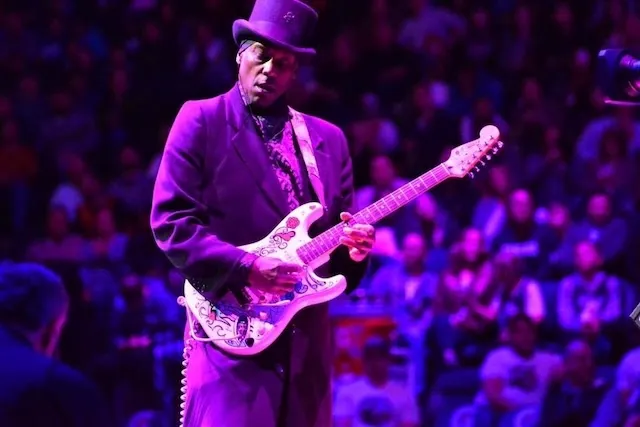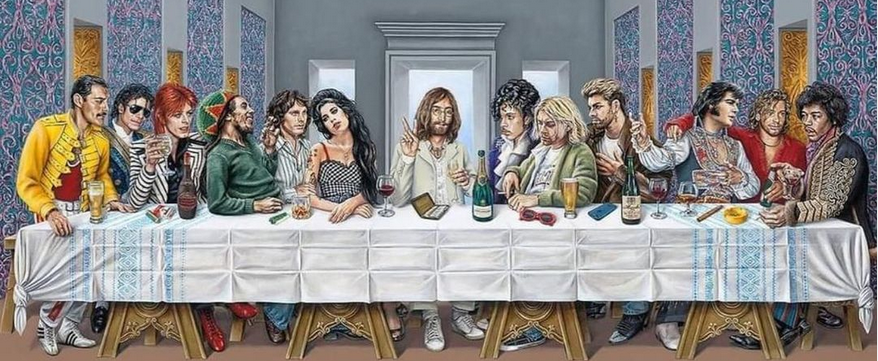
Jellybean Johnson was born Garry George Johnson on November 19, 1956, and was an American drummer, guitarist, songwriter, record producer, and one of the most defining musicians to emerge from Minneapolis, Minnesota.
His career spanned five decades, touching multiple generations of artists, and leaving an indelible imprint on the musical landscape of the United States. Known for his versatility, warmth, technical skill, and deep love for community, Jellybean became both a cornerstone and a custodian of the Minneapolis Sound — a cultural movement as much as a musical one.
Early Life and Formative Years
Garry Johnson was born in Chicago, Illinois, into a family that prized hard work and creativity. His parents encouraged him early on to participate in music, giving him access to instruments, community centers, and local arts programs. When he was still a child, his family relocated to North Minneapolis — a move that would change the trajectory of his life forever.
The Twin Cities, in the late 1960s and early 1970s, was a fertile musical ground. Local clubs featured everything from funk to rock, fusion to jazz, and youth centers regularly buzzed with teen musicians eager to experiment with sound. Johnson was one of these teenagers. He began taking drum lessons around age 13, quickly developing a natural feel for rhythm. A couple of years later, he taught himself guitar — a decision that would ultimately make him a multi-instrumental powerhouse decades later.
During his teenage years, Johnson attended Marshall-University High School in Minneapolis. Although he was athletic and played basketball for the school, it was always music that called him most strongly. He also took classes at the University of Minnesota for a period, but the pull of the stage ultimately took precedence. Music was not just a hobby; it was becoming a vocation.
Entry Into the Minneapolis Music Scene
North Minneapolis in the 1970s was home to a burgeoning R&B and funk scene. Jellybean Johnson became part of several early bands, most notably a group called Wars of Armageddon. This ensemble would later evolve into Flyte Tyme, a group that included future legends such as Jimmy Jam and Terry Lewis. The collective was full of young musicians who were serious about developing their craft, and Johnson emerged as one of its most adaptable performers — able to switch between drums and guitar with ease.
Flyte Tyme played local clubs, talent shows, and community events, gaining a reputation for tight musicianship and an energetic stage presence. Many of the band members, including Johnson, were teenagers at the time, but their professionalism and skill far exceeded their age. This tight-knit musical circle would soon intersect with another rising Minneapolis force: Prince Rogers Nelson.
Joining The Time: A Breakthrough
Prince, searching for musicians to form a complementary group that could embody the swagger and groove of the Minneapolis Sound, recruited heavily from Flyte Tyme. This led to the formation of The Time, a band created as part of Prince’s ever-expanding musical universe.
Jellybean Johnson became The Time’s drummer — a position that would bring him national exposure and define the first major chapter of his career. The Time, fronted by the charismatic Morris Day, combined funk, R&B, and rock with a theatrical flair and tongue-in-cheek bravado. Johnson, as the drummer, laid the rhythmic foundation for their explosive live performances. He brought precision, energy, and groove to the band’s unique aesthetic.
.
The Time became particularly well-known for their appearances in the film Purple Rain, in which Jellybean Johnson played a fictionalized version of himself. The movie immortalized the dynamic between Prince and The Time and showcased the band’s musical excellence to millions of viewers worldwide. Johnson’s presence in that film embedded him forever in the cultural memory of the 1980s.
Evolution Into a Multi-Instrumentalist and Producer
Although Jellybean Johnson first rose to fame as a drummer, his musical curiosity and talent pushed him far beyond that role. Behind the scenes, he was honing his skills on guitar, learning to shape tones and solos, exploring harmony, and absorbing various musical genres — jazz, blues, rock, soul, and more.
After his tenure as drummer for The Time began to evolve, he increasingly took on guitar and production work. His transition was seamless. Johnson became a highly sought-after session musician, playing guitar for numerous artists and delivering performances that were both technically impressive and emotionally expressive.
Perhaps one of the most celebrated examples of his early guitar work is his blistering solo on Alexander O’Neal’s track “Innocent,” a nearly ten-minute R&B-funk opus. The second-half guitar solo, performed by Johnson, was so powerful and distinctive that it received praise from major figures in the industry.
His work as a guitarist opened doors, but his ambitions didn’t stop there. As Flyte Tyme evolved into a production powerhouse under the guidance of Jimmy Jam and Terry Lewis, Johnson became an integral part of their creative team. He contributed as a co-writer, arranger, and producer on countless recordings, developing a reputation as a musician who understood both the technical and emotional dimensions of record-making.
Career as a Producer and Collaborator
Throughout the 1980s and 1990s, Jellybean Johnson contributed to a remarkable number of high-profile projects. His connection to Flyte Tyme meant that he was part of the creative energy behind many R&B, pop, and funk hits of that era. He worked with artists including:
- Janet Jackson – He co-produced her rock-infused hit “Black Cat,” helping shape a sound that marked a departure from her earlier work. His contributions helped drive the song to major chart success.
- Mint Condition – He produced tracks on their debut album, which launched the band to widespread acclaim and helped define a new generation of Minneapolis soul.
- New Edition – Johnson contributed to the group’s evolving R&B sound during a pivotal moment in their career.
- Nona Hendryx, Alexander O’Neal, and others – His production, guitar, and drumming lent depth and personality to their recordings.
Johnson was the rare musician who could walk into a studio and operate as drummer, guitarist, producer, arranger, and creative mentor all at once. His collaborative spirit made him beloved among artists, and his versatility made him invaluable in sessions.
Cultural Role and Community Influence
Despite working with internationally recognized stars, Jellybean Johnson never abandoned his Minneapolis roots. In fact, he became one of the city’s most visible musical ambassadors. He regularly played in local venues, particularly blues and funk clubs, supporting younger artists and staying deeply engaged with the community.
He viewed mentorship as a responsibility. Johnson often referred to younger musicians as his “musical nieces and nephews,” helping them navigate not only musical challenges but the complexities of life in the industry. His guidance shaped many rising Twin Cities performers who admired both his skill and his generosity.
Later in life, Jellybean Johnson became increasingly dedicated to preserving the history of the Minneapolis Sound. He founded the Minneapolis Sound Museum, a nonprofit devoted to honoring and archiving the legacy of the musicians, producers, and cultural forces that shaped this distinctive style. For Johnson, this was not simply nostalgia — it was a form of community ownership, ensuring that the contributions of Minneapolis artists were never erased or forgotten.
Solo Career and Artistic Renaissance
Although he had been part of some of the most influential music projects of the late 20th century, Jellybean Johnson did not release a solo album until his mid-sixties. His debut project marked a long-awaited step into a new phase of self-expression. Unlike his earlier work where he supported or collaborated, this project allowed him to fully define his artistic vision.

.
On his solo record, Johnson emphasized guitar — the instrument he had fallen in love with as a teenager. He chose not to sing, allowing guest artists, younger musicians, and vocalists he admired to handle the lyrical and melodic expression while he focused on composition, arrangement, and instrumental storytelling.
The result was an album rich with blues textures, funk rhythms, soulful solos, and musical dialogues between the old school and the new. It was a portrait of a musician who had lived a full life in music and who wanted to distill that experience into one final artistic statement.
Later Years and Continued Performances
Even into his late sixties, Jellybean Johnson continued to perform relentlessly, often appearing onstage five or six nights a week. His stamina, passion, and enthusiasm were remarkable. Younger musicians marveled at his energy; audiences admired his humility and warmth. He played with both veteran artists and up-and-coming performers, always adapting, always listening, and always ensuring that the music remained at the center of everything.
He reconnected at various points with members of The Time and related musical groups, participating in reunions, special concerts, and celebrations of the Minneapolis Sound. When The Time received major recognition and lifetime achievement honors, Johnson stood proudly alongside his longtime collaborators, acknowledging their shared journey.
Personal Life
Jellybean Johnson was known to be a private person despite his public career. He was a devoted father to several children and a constant presence in the Minneapolis community. Those who knew him personally described him as kind, patient, humorous, and thoughtful — someone who never allowed fame or industry politics to affect how he treated others.
He enjoyed simple pleasures: live performance, connection with fellow musicians, time with family, and the satisfaction of helping younger artists find their voice. Music was his calling, but people were his passion.
Final Reflections and Passing
In the final year of his life, Jellybean Johnson reflected openly on his journey. He spoke often about gratitude — gratitude for the chance to make music, for the community that raised him, for the artists he worked with, and for the legacy he hoped to leave behind.
Jellybean Johnson died on November 21, 2025, just two days after his 69th birthday. His death sent ripples throughout Minneapolis and the global music community.
Legacy
Jellybean Johnson’s legacy is multifaceted and deeply felt.
As a performer, he excelled on both drums and guitar, demonstrating extraordinary versatility.
As a producer, he contributed to some of the defining R&B and pop records of the 1980s and 1990s.
As a cultural figure, he helped forge and sustain the Minneapolis Sound, a musical movement that remains influential to this day.
As a mentor, he shaped the next generation of musicians with generosity and sincerity.
As a preservationist, he ensured that the story of Minneapolis music would be protected for the future.
Garry “Jellybean” Johnson remains a symbol of artistic excellence fused with humility, a reminder that great musicians are not only those who shine onstage, but those who elevate everyone around them.
Check out Jellybean Johnson on Amazon by clicking here.
If you found this interesting please share it with your friends and family, and check out some of our other articles on Musicians who Died in 2025.
.

